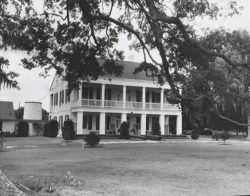Mulberry Grove Plantation
Before its restoration in the 1950s, the Mulberry Grove Plantation house was being used as a hay barn.

Courtesy of
Mulberry Grove Plantation House. Coleman, Howard (Photographer)
Tituated on a little-traveled stretch of the Mississippi River’s west bank between White Castle and Donaldsonville, Mulberry Grove Plantation is set back from the River Road behind a broad lawn.Dr. Edward Duffel, from Virginia, had this two-story house constructed for his Acadian bride, Celeste Landry. A brick lower story and frame second story, French doors on the second floor and an exterior staircase on the rear gallery, show that the house was faithful to Louisiana’s Creole traditions. However, its symmetrical central-hall plan and the Greek Revival front and rear galleries supported on piers reveal Anglo-American influences. The Greek Revival style is also visible in the row of dentils along the entablature, pediment-shaped lintels, and shoulder molding over doors and windows.
A few dependency buildings survive, among them a large barrel-shaped cypress cistern (ca. 1836) raised on a circular brick base, a board-and-batten privy (ca. 1890), and (to the left and facing the highway) a row of four two-room workers’ cabins (also ca. 1890), which have scroll-shaped bargeboard decoration on their end gables. After the Civil War, John B. Reuss purchased the plantation to add to his other holdings in the parish; in the twentieth century, the house had several different owners. In the 1990s, an elevator tower was added to one side of the house. Mulberry Grove is still a working plantation amid the sugarcane belt of the upper River Parishes.
Adapted from Karen Kingsley’s Buildings of Louisiana, part of the Buildings of the United States series commissioned by the Society of Architectural Historians and published by Oxford University Press.
